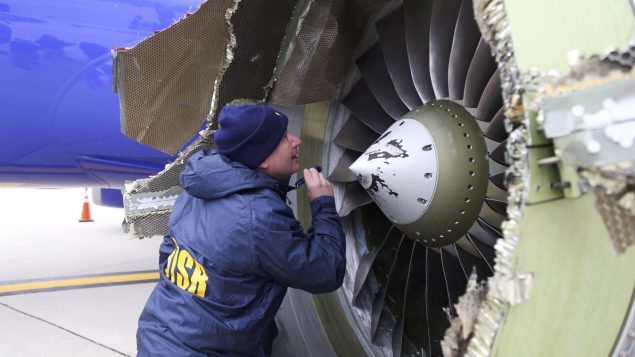U.S. airline regulators have ordered inspections of engine fan blades after one broke off during a Southwest Airlines flight yesterday. Debris ruptured a window and a woman was partially sucked out of the jet and then was pulled back in by other passengers. They were unable to resuscitate her.

Valiant attempts were made to save Jennifer Riordan but they were unsuccessful. (Marla Brose/The Albuquerque Journal via AP)
Many threats to life
“At 31,000 feet there isn’t enough oxygen to sustain life for more than a few seconds,” says Keith Mackey, president of the aviation consulting firm Mackey International and a former airline captain.
“So, she had traumatic injuries from going through the window, from being pulled back in, from being exposed to the high velocity air at jet speeds and the very low density of air at 31,000 feet. So, there was a series of events, any one of which probably could have caused her death.”
Listen
Former pilot Keith Mackey believes this engine failure to be a on-off and something unlikely to happen again.
It was ‘a compound emergency,’ says former pilot
Mackey says the crew would have had to suddenly deal with three emergencies. First, they would have heard the engine explode and cabin indicators would have signalled a loss of power. They would have been concerned there might be fire in that engine, because while there are warning indicators for that, they can be knocked out by fire.
Almost immediately after, there would have been a decompression which would automatically release oxygen masks. In such, pilots normally would descend the plane rapidly to a lower altitude. But since the decompression was no doubt caused by a breach in the structure of the plane, the pilots would have been worried about preserving the structural integrity of the jet and would have had to descend more slowly to minimize stress on the structure.
Then they had to coordinate with the flight attendants to find out what was going on in the cabin and talk to air traffic controllers to make sure the airspace was clear and find a place to land. They also had to instruct air traffic control as to what their needs would be once on the ground.
Entire crew lauded
While there has been much acclaim for the pilot, Mackey reminds us that it was the action of the entire crew that brought the crisis to the best possible conclusion given the circumstances. “I think the crew just did a great job. But this is what they were supposed to do. This is how crews are trained. This is how you’re supposed to react to an emergency…From their perspective, it turned out as well as it could have.”

Close inspection determined that a fan blade likely broke off causing the engine to fail. (National Transportation Safety Board via AP)
‘A very reliable engine’
The engine that failed is one that is commonly used on 737 jets all over the world. There are thousands of them and they have logged millions of hours with little to no problems, says Mackey. They will be inspected but in the meantime, he says people should not worry about flying in planes powered by them.
“It’s a very reliable engine. So, this is a very unusual event and it’s nothing for people to be concerned about…You’re probably much more likely to get struck by lightning on the way to the airport than you are to have an engine explosion.”







For reasons beyond our control, and for an undetermined period of time, our comment section is now closed. However, our social networks remain open to your contributions.